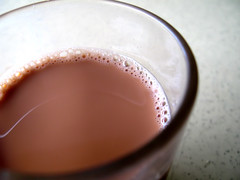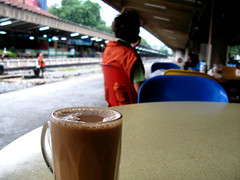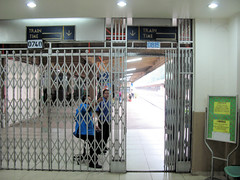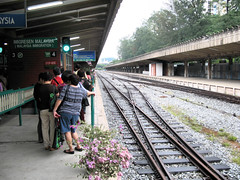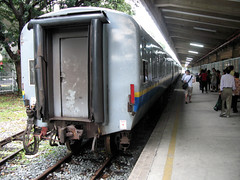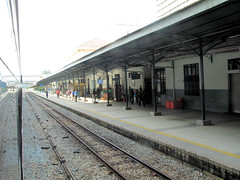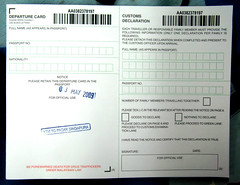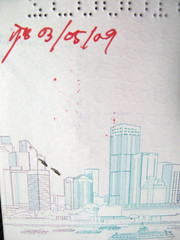I do not remember exactly how and when I got to know about George Photo. From young, my family made the occasional trip to Changi Village for food and recreation. At the junction of Changi Village and Telok Paku Road, I would never fail to catch a glimpse of this photo shop at the corner of Blk 1 – just to make sure it is there. I have never ventured into George Photo, perhaps it never struck me this quaint little shop would be gone one day.
As I grew older, the car made less left turns into Changi Village/Netheravon Road from Loyang Avenue. Previously we used to frequent the
zi char stall at Blk 5
for dinner. We also swam and ate at the Civil Service Club. Nowadays, we only eat at the food centre next to the bus terminal and our car is always parked behind Blk 1. Little wonder I did not notice the passing of George Photo in February 2007.
**********
No heritage adventure to share or second shot to show today, instead I will attempt to solve the
mystery of how George Photo got its name. The question was asked by reader
The Bakerwoman in her comments on
Good Morning Yesterday. In fact she had a few questions. Snippets:
I would like to know his father's actual name.....was it also George Chang Snr? Who named the shop George Photo? Was it George Snr or the present George Jnr? Did a fire break out in the 60's within the block 1 vicinity? Was it also called George Photo in the 60's?
I conducted my own research and here is what I have found from websites and books.
George Photo in the 1960sAccording to Peter in his
comments, “Blk 1 was a row of zinc roof shops” and the current blocks were only built in the 1970s. From this
report, George Photo should be located to the west of the main road, i.e. opposite Blk 1. The same report also shows the shop in its former zinc roof glory:

There is good reason to believe the shop was already called George Photo in the 1960s.
The Disastrous Fire of 1970Mr George Chang also wrote of a disastrous fire in 1970:

I’m unsure of the extent of the damage. But if everyone suffered losses, it must be serious. I wonder how George Photo was affected. Were some precious photos of Changi lost to the fire?
Actual Name of George Chang’s Father
According to Peter in his
comments, Mr George Chang’s father is George Chang, i.e. both father and son are named George. This I could not verify through research.
But I may have found the actual chinese name of George Chang's father. I say 'may' because nagging question remain.
The Changi PhotographerI do not know George Chang personally. Unlike the old-timers and NS men who dropped by, I would not have known about the shop if not for its connection to wartime history.In August 1942, there was the
Selarang Barracks Incident and this historical 'Great Squeeze' where 15,000 POWs were crammed into barracks designated for 1200 is documented in pictures taken by an Australian POW.
 The POW is George Aspinall (picture below) and he took other secret shots (unauthorized of course) beside those of Selarang Barracks Incident. One wonders how he lived to tell his tale. The Sony Cybershot T50 hadn't been invented yet for sure.
The POW is George Aspinall (picture below) and he took other secret shots (unauthorized of course) beside those of Selarang Barracks Incident. One wonders how he lived to tell his tale. The Sony Cybershot T50 hadn't been invented yet for sure.

How was George Photo related to wartime history? As a matter of fact, George Aspinall knew George Chang's father personally. A mention of their relationship is staple in any extended report on George Photo, for example the Electric New Paper of 16 February 2007,
Mr Chang's father befriended him and before long, was teaching him the tricks of the darkroom trade.
The darkroom trade was to prove useful to George Aspinall later, when he was a POW (exactly how, read
here).
I do not know George Aspinall personally, but I've read the book by Tim Bowden on him -
Changi Photographer: George Aspinall's Record of Captivity. I re-read the book for my research.
George Chang's FatherOn page 19, George Aspinall recounted how he met George Chang's father:
I had become a keen photographer during that time, but I didn't know much about processing photographs. I got to know a Chinese photographer called Wong Yeow, who had a photographic shop in Changi Village.
If you read further, you'd realize Wong Yeow and Mr Chang's father are the same person. Presumably, George Chang's father is Chang Wong Yeow. We also read about an unnamed photographic shop.
The Origin of George PhotoHere is where research gets interesting. George Aspinall revealed how George Photo got its name! Here is a scan from the book (page 19):

So George Photo was named after George Aspinall, according to Sue (Chang). That was what I wrote in my comments on
Good Morning Yesterday.
If George Aspinall was surprised at the name, we can logically conclude the unnamed photographic shop in 1942 was not called George Photo. Perhaps the shop had a Chinese name and our Caucasian protagonist could not read the Chinese characters.
The Nagging QuestionsHave I solved the mystery? Well, I believe so, but I'm not sure. I may have solved the mystery, however nagging questions remain. The jigsaw pieces do not fit nicely.
1. George Aspinall did not call his friend Chang Wong Yeow. As you read page 19 of the book, you get the impression Wong is the surname and Yeow the personal name:
I used to look forward to going down to Changi Village to see Wong.
It happens that Wong is a common surname, but try substituting your brother or father's middle name. I shall be bold and use Lam Chun See as example (don't kill me please). Normally you'd say "I'm going down to see See", not "I'm going down to see Chun". Ok, I know the former is funny as well (see see?), but well .......
2. I have not met Mr George Chang, but according to this 2007
article, he is in his 50s. Assuming 55 years old, he would be born in the 1950s. Following the usual generation gap rule of 30 years, his dad (Chang Wong Yeow) would be in his late teens or early 20s during the Japanese Occupation. Makes sense right? After all George Aspinall was of NS age in 1942. People in the same age group tend to 'click' better. George Aspinall summarized their relationship, "we became quite good friends".
But wait, read how George Aspinall described Wong Yeow:
We became quite friendly. He was an amiable bloke in his mid-forties and he taught me quite a bit about processing film and printing it. I used to spend about two nights a week there for the first five weeks we were in Singapore.
Mid-forties?! That would mean Wong Yeow was born at the turn of the century. While not logically impossible, this would mean Wong Yeow was around 60 at the birth of his son George Chang!
In contrast, Sue's age makes more sense. She was born around 1934, when Wong Yeow was around 40.
3. The daughter Sue presents another difficulty. She was the 'missing link' between George Chang and Wong Yeow but never mentioned in sources. Does George Chang have a sister Sue? You get this impression George Chang took over the business from his dad directly.
According to the book, Wong Yeow died in 1971 and presumably Sue took over the business. The young George Chang might have helped, but according to the 2007 article,
Now, after taking over and running the shop for 31 years, Mr Chang will close shop because of poor business.
From the context, Mr Chang took over the shop from his father. Counting the years, that would be in 1976, but Wong Yeow had died in 1971. Who was the boss during the interim years?
4. This last one has to do with George Chang. This is purely speculation, but I have this nagging feeling George Chang, George Photo and George Aspinall are related. If George Photo was named after George Aspinall, what could be the reason? Did Wong Yeow meet George Aspinall again after the war? Was George Chang named after George Aspinall?







